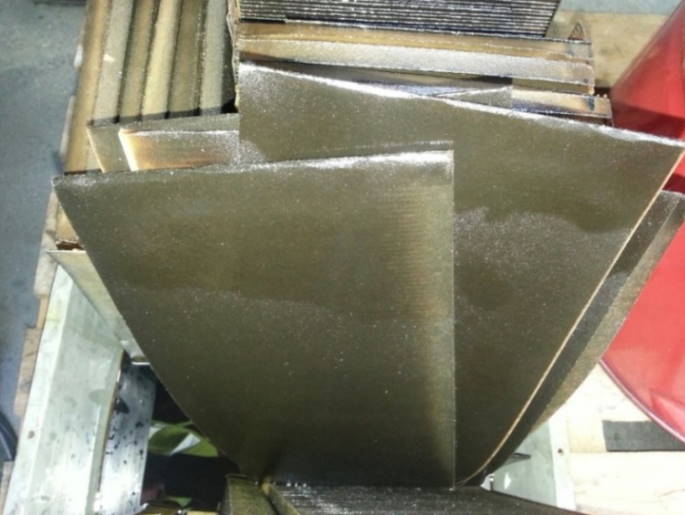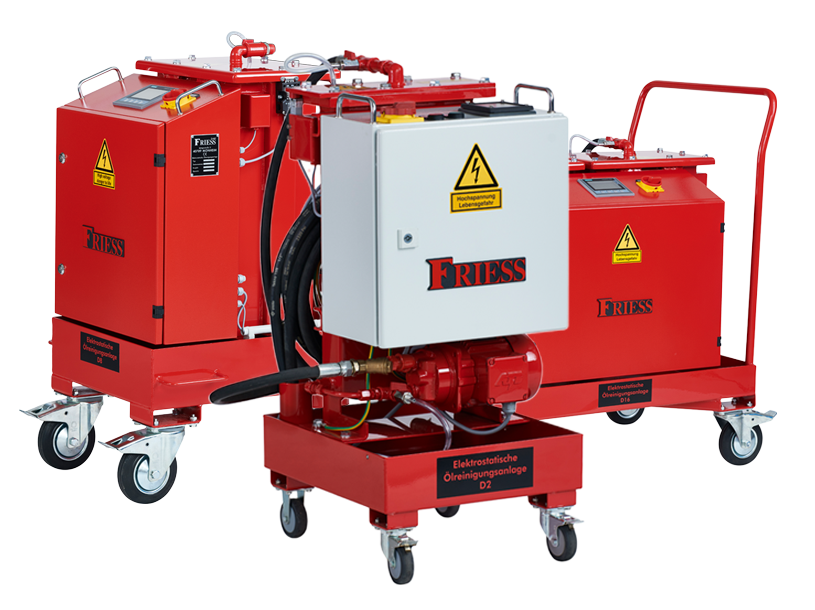FRIESS-EFC electrostatic oil cleaning in the aluminum industry
Aluminum profiles are produced on big hydraulic extruding presses. The production process starts with round aluminum material. The hot aluminum is pressed by a powerful hydraulic press through the tool. The necessary high force is generated by one single hydraulic cylinder. In order to drive the hydraulic cylinder normally several pumps, servo valves and a hydraulic tank with a volume between 10000 l and 40000 l of hydraulic oil is necessary. In order to achieve a constant quality of the produced aluminum profiles, it is necessary, that the press capacity and the form feed of the cylinder is regulated as precise as possible. In order to achieve a precise movement of the hydraulic cylinder the hydraulic oil has to be as clean as possible.
Situation
An aluminum factory in West Germany uses tow hydraulic presses. Each press has a hydraulic oil volume of approx. 12000 l HLP 46. Because of the contamination of the hydraulic oil the production team had to fight with hydraulic failure and wrong movements of servo valves. In order to improve the cleanliness of the oil the maintenance manager decided to install a bypass filter system.
 FRIESS EFC D16 and bypass filter at hydraulic press
FRIESS EFC D16 and bypass filter at hydraulic press
Solution
The bypass filter was able to remove bigger particles. The bypass filter system was not able to remove micro particles, oxydation products and resins, which are the real cause for the failure in the hydraulic system. In order to improve the situation the maintenance manager decided to pump the oil from the storage tank into separate IBC. In the next step they cleaned the hydraulic tank from the inside. During cleaning they found on the bottom of the tank and on the walls of the tank many impurities like resins and sticky oxydation products. After cleaning the hydraulic tank they pumped back the used hydraulic oil into the system. This labor intensive procedure did not cause any improvements.
Result
After contacting the oil manufacturer the maintenance manager decided to test an electrostatic oil cleaning system FRIESS EFC D16. After 2000 hours of operation the oil was checked. The analysis showed that the oil was still contaminated with lots of oxydation products. At the same time the cleaning elements of the electrostatic oil cleaner model D16 were checked as well. The cleaning elements were completely contaminated with oxydation product, sludge and resin.
 Resin and oxydation products on the surface of the cleaning elements
Resin and oxydation products on the surface of the cleaning elements
Although the company uses bypass filter systems oxydation products and resins are generated in the hydraulic oil during the normal operation. Caused by temperature, oxygen and with the help of catalyst the oil molecules are able to react with oxygen from the air. In the first step the oil molecules will change to longer-chain chains, which do not cause further damage. Because of the bigger size of the molecules the bigger molecules will polymerize to resin or jelly-like soft particles. The sticky resins and soft contaminations will stick to the surface of valves, piston and pumps and so on. On the surface of the hydraulic components you can see a brownish layer which looks like lack. The resins are very soft and will pass filter pores without problem and remain in the oil although filters are used. During the operation of the oil more and more hard resin particles and varnish with incorporated metallic particles will stick to the surface of hydraulic components. At the end it will happen, that the sticky oxydation products and varnish will block the piston of the servo valves and the servo valves will not react as normal.
The result is malfunction of the hydraulic system and the operator has to change the servo valve. The electrostatic oil cleaner EFC D16 is able to remove the oxydation product, resin and varnish from the oil. The oil cleaned by electrostatic contains less varnish and is able to solve settled oxydation product and varnish from the surface of the hydraulic components.
The surface of the valves, of pumps, pistons and other hydraulic components becomes clean again. The movement of the different components is not blocked by the varnish and the hydraulic system will work more precise and without malfunction.
After the installation of the electrostatic oil cleaning system model D16 the hydraulic system of the aluminum press works now without hydraulic failure.
 FRIESS EFC D16 electrostatic oil cleaning machine D16 at hydraulic extruder
FRIESS EFC D16 electrostatic oil cleaning machine D16 at hydraulic extruder
